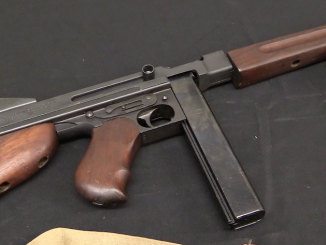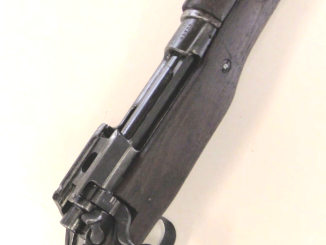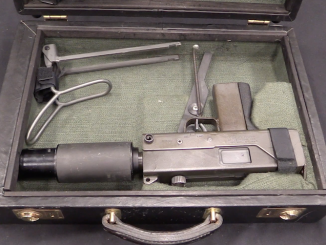In late 1940, the US military opened a competition for what would become the M1 Carbine – a rifle that needed to use the .30 Carbine cartridge and weigh no more than 5 pounds (2.27kg). No fewer than 9 companies and designers entered the first round of competition in April 1941, including John Garand, Val Browning, Eugene Reising, Auto-Ordnance, and George Hyde. Hyde’s entry was one of the best performers, and just a few changes to it were requested.
A second round of trials was held in September 1941, and this is one of the 5 Hyde carbines made for that second test. Unfortunately for Hyde, while he had made the changes requested, he had also managed to make the gun less accurate, less reliable, and more difficult to disassemble than his first version. Winchester would ultimately win the competition, with a rifle designed in an amazing 34 days.




Fantastic! Very, very interesting. Thanks!
Is it the case that absent the winning Winchester, this was the design effort that was more favored by the Ordnance bureau?
Really interesting little rifle. Thanks.
a quick question about the disconectors
there appeared to be a spring loaded disconector on the end of the trigger extension. relying on over travel to disconect the trigger from the sear.
was that a second disconector sear beside the one that the trigger was contacting?
You can get a better look at the trigger mechanism from a print of his first design on this site.
I believe you are correct in your assumption that the second sear is a safety sear. You can see this in Garand’s designs where the trigger pack has a safety sear as well as designs to make sure there is no out of battery fire.
Looks like auto sear, but i think its actually safety sear to prevent rifle from being fired out of battery.
2407157, 2367280, 2342283, 2049776… Four US Patent Numbers of inventor. Each has different trigger mechanism and the one demonstrated in Ian’s video looks like a combination.
Appearently; Camming link of breechbolt has an inward lug pressing over the second sear when the gun is unlocked and lowering the same out of reach of spring actuated trigger connector plunger as disabling it to actuate the releasing left/first sear. This looks like an effective “Battery Off” safety which seems compulsory for a gun with an escaping disconnector like this one carries.
Sorry for wrong explanation. Camming lug should work just opposite; Pressing down the safety sear when the gun is locked and leaving the first/release sear alone for trigger control, and releasing it when the gun is unlocked. Contrary to my first opinion; The second sear should be the real disconnector since camming back the trigger connection plunger when rising upwards in the gun is in locked situation if the triggeer is pressed. Trigger connection plunger and second sear combinely work as a positive disconnector. IMHO.
Yuck! No wonder Hyde lost! Complexity addiction is generally going to kill your design if the stuff could be done in a cheaper and simpler manner.
For similar case see, Polish MORS sub-machine gun:
https://www.forgottenweapons.com/submachine-guns/wz-39-mors/
MORS, 1st iteration was feasible, but finally it become long weapon for sub-machine gun, featuring barrel-change mechanism, mono-pod in grip, pneumatic rate-of-fire reducer.
EXCELLENT!
Thanks Ian.
Too bad the magazine is AWOL.
Regards
Pat
The Winchester design later resurfaced in modified form in the 1950s trials that culminated in the adoption of the AR-15/M16 .223 rifle.
The Winchester .224 Light Rifle was internally very similar to the M1 carbine. At the same time, Harrington & Richardson entered a design that was basically a scaled-down T-47 rifle (the forerunner of the M14).
The AR-15 beat them both out mainly because, as one test commission member put it, it had more “sex appeal”, visually speaking.
Today, the Ruger Mini-14 is basically the Winchester’s gas system with the M1 Garand/M14 type searage, etc., of the H&R prototype. Which is why it field-strips like a combination of a Carbine and an M14.
cheers
eon
I’d disagree with the Mini 14 having the Winchester gas mechanism, if by that you mean the Williams tappet / captive short stroke piston.
What Ruger does manage is a very useful addition of weight to the operating handle assembly, in a way that remains hidden from view, and a reduction in weight of that part of the gas system which remains attached to the barrel and stationary.
Arguably Kalashnikov did it better, by eliminating the kink in the garand operating rod, and putting the increased mass in the bolt carrier, then adopting the safety lever and aesthetics of the J M Browning / Remington Model 8.
The scaled down T47 sounds interesting, are there any pics of it?
Looks like the M1carbine,BAR,and Thompson smg got together and had a child. Good to see a close up of this development platform.
Mannlicher’s locking wedge strikes again!
I like the way this rifle is well sealed from dirt in the action. And it looks more like a ZH29’s child.
Ahhh, yet another “what could have been”.
Man, if you could get your hands on a first model and make a comparison video, that would be absolutely amazing.
I’m a fan of the first version ! Just changing the op rod would have been enough. Add a side folding steel skeleton stock and we have an almost there assault rifle that would have been excellent. Perfect for paratroops!
I suspect the more conventional look of the M1 Carbine had a significant part to play in it’s selection as well?
Likely so. The wartime pressure wasn’t really on yet. That demand would finally result in the M3 SMG being adopted and that must have really upset those conventional sensibilities!